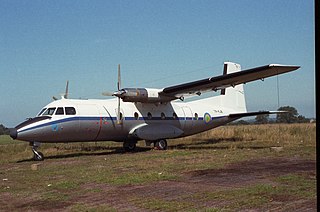Related Research Articles

The Pratt & Whitney J75 is an axial-flow turbojet engine first flown in 1955. A two-spool design in the 17,000 lbf (76 kN) thrust class, the J75 was essentially the bigger brother of the Pratt & Whitney J57 (JT3C). It was known in civilian service as the JT4A, and in a variety of stationary roles as the GG4 and FT4.

The Napier Gazelle is a turboshaft helicopter engine that was manufactured by D. Napier & Son in the mid-1950s. In 1961 production was nominally transferred to a joint venture with Rolls-Royce called Napier Aero Engines Limited. But the venture closed two years later.

The Armstrong Siddeley Viper is a British turbojet engine developed and produced by Armstrong Siddeley and then by its successor companies Bristol Siddeley and Rolls-Royce Limited. It entered service in 1953 and remained in use with the Royal Air Force, powering its Dominie T1 navigation training aircraft until January 2011.

The Bristol Thor, latterly Bristol Siddeley BS.1009 Thor, was a 16-inch (41 cm) diameter ramjet engine developed by Bristol Aero Engines for the Bristol Bloodhound anti-aircraft missile.

The Franklin O-150 was an American air-cooled aircraft engine of the late 1930s. The engine was of four-cylinder, horizontally-opposed layout and displaced 150 cu in (2 L). The power output was nominally 40 hp (30 kW).

The Turbomeca Bastan was a turboprop engine developed in France in 1957. Early models developed 650 shp (485 kW), but by 1965 this had been increased to 1,048 shp (780 kW) with the Bastan VII.

The Turbomeca Astazou is a highly successful series of turboprop and turboshaft engines, first run in 1957. The original version weighed 110 kg (243 lb) and developed 240 kW (320 shp) at 40,000 rpm. It was admitted for aviation service on May 29, 1961, after a 150-hour test run. The main developing engineer was G. Sporer. It was named after two summits of the Pyrenees.

The Agusta GA.70 was a four-cylinder, air-cooled, horizontally opposed engine developed in Italy for light aircraft and helicopter use. The GA.70/V featured a bottom sump for vertical applications and was rated at 61 kW (82 hp). It was produced in the 1950s and 1960s.
The Agusta GA.140/V is a 4-cylinder, air-cooled, horizontally opposed engine mounted vertically, developed in Italy for helicopter use and produced from 1962 to 1969.

The Praga Hostivař D was a four-cylinder, air-cooled, horizontally opposed aircraft engine first produced in Czechoslovakia in 1936 but which enjoyed its greatest success after World War II due to the explosion in popularity of sports flying. A version for helicopters was produced post World War II as the Praga DH

The Alfa Romeo 115 was an Italian six-cylinder air-cooled inverted inline engine for aircraft use, mainly for training and light planes, based on the de Havilland Gipsy Six engine. Production totalled approximately 1,600 units. Derivatives of the 115 include the -1, bis, ter and Alfa Romeo 116.

The Alfa Romeo 121 was an eight-cylinder, air-cooled, inverted V engine for aircraft use produced in Italy. It was typically rated at 280 kW (380 hp).

The Alfa Romeo 110 was an Italian four cylinder air-cooled inverted inline engine for aircraft use, mainly for trainers and light aircraft. The Alfa Romeo 110 was based on the de Havilland Gipsy Major, with approximately 500 units produced. Derivatives of the 110 include the -1, ter and Alfa Romeo 111.

The General Electric T64 is a free-turbine turboshaft engine that was originally developed for use on helicopters, but which was later used on fixed-wing aircraft as well. General Electric introduced the engine in 1964. The original engine design included technical innovations such as corrosion resistant and high-temperature coatings. The engine features a high overall pressure ratio, yielding a low specific fuel consumption for its time. Although the compressor is all-axial, like the earlier General Electric T58, the power turbine shaft is coaxial with the HP shaft and delivers power to the front of the engine, not rearwards. Fourteen compressor stages are required to deliver the required overall pressure ratio. Compressor handling is facilitated by 4 rows of variable stators. Unlike the T58, the power turbine has 2 stages.

The General Electric CF700 is an aft-fan turbofan development of the CJ610 turbojet. The fan blades are an extension of the low-pressure turbine blades.

The Boeing T50 was a small turboshaft engine produced by Boeing. Based on Boeing's earlier Model 500 gas generator, the T50's main application was in the QH-50 DASH helicopter drone of the 1950s. An up-rated version designated Model 550 was developed to power the QH-50D and was given the military designation T50-BO-12.
The Boeing T60 was a family of small turboshaft/turboprop engines produced by Boeing, based on Boeing's earlier Model 500 gas generator and Model 502 (T50) turboshaft engines.
The Potez 4E is a French air-cooled flat-four piston engine of the 1960s. It was unveiled at the 1959 Paris Air Show, entered production in 1960 and is rated at 78 kW (105 hp). It remained in production until 1965 when Potez abandoned production of aero-engines.

The Walter Regulus was a Czechoslovakian five-cylinder, air-cooled radial engine for powering light aircraft that first ran in 1934. The engine produced 186 kW.
The Fiat 4700 was an Italian turbo-generator developed by Fiat Aviazione under contract to the Italian Defence Ministry and used to power the experimental Fiat 7002 tip jet helicopter.
References
- Taylor, John W.R. FRHistS. ARAeS (1962). Jane's All the World's Aircraft 1962-63. London: Sampson, Low, Marston & Co Ltd.